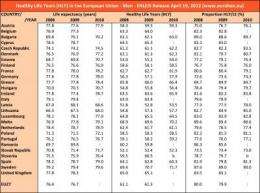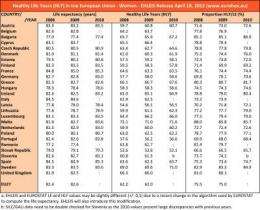Life expectancy and healthy life years in the European Union, 2008-2010

The HLY (Healthy Life Years) indicates how long people can expect to live without disability. It has been computed annually for each Member State of the European Union since 2005. These figures are released in the framework of the first annual meeting of the European Joint Action on Healthy Life Years (EHLEIS), organized in Paris on April 19, 2012 (ASIEM, 6 rue Albert de Lapparent, from 1:30pm) by the French Ministry of Health. The European Joint Action on Healthy Life Years (EHLEIS) is led by FRANCE, and coordinated by the French National Institute of Health and Medical Research (INSERM).
In 2009 men in the European Union (EU27) could expect 61.3 Healthy Life Years (HLY), representing almost 80% of their life expectancy (LE) at birth of 76.7 years. Women could expect 62 HLY, 75% of their life expectancy (LE) at birth of 82.6 years in 2009.
2010 values for men
In 2010, Sweden has the longest life expectancy at birth (79.6 years) for men in the European Union and Lithuania the shortest (68 years), a gap of almost 12 years. Swedish men also have the most Healthy Life Years (71.7 years) with men in the Slovak Republic having the least (52.3 years), a gap of almost 20 Healthy Life Years. And again Sweden has the highest proportion of years lived without disability (HLY/ LE) in 2010 with 90% of life expectancy without limitations in usual activities. Men in the Slovak Republic on the other hand spend the lowest proportion without disability (73%), a difference of 17 percentage points. This suggests that for men the longer the life expectancy the greater the proportion lived without disability.

In this short period 2008-2010 and despite its low life expectancy and HLY for men, Lithuania experienced the largest gain in HLY, almost three years, whilst the Netherlands saw the largest decline (a loss of 1.3 years). So there is also a tendency for health expectancies in Europe to converge since the gap between Lithuania and the Netherlands fell by more than four HLY in just 3 years. See attached tables for all figures 2008-20010 by Member State.
Better health outcomes for women
In 2010, France and Spain have the longest life expectancy at birth (85.3 years) for women in the European Union and Bulgaria the shortest (77.4 years), a gap of nearly eight years. In 2010 Malta has the highest HLY (71.6 years) for women and the Slovak Republic the lowest (52.1 years), the gap being the same as for men at almost 20 years. However for women in 2010, it is in Bulgaria that the proportion of years lived without disability (HLY/LE) reaches its maximum with 87% of life spent free of activity limitation. This contrasts with the Slovak Republic where women spend the shortest proportion (66%), a difference of 21 points. The results for Bulgaria show that a short life expectancy combined with a low prevalence of activity limitation leads to a large proportion of life expectancy apparently free of disability.
In the short time period 2008-2010, it is again Lithuania that experienced the largest gain in HLY in women (2.4 years), confirming the observation made for men, whilst Finland saw the largest decline (a loss of 1.7 years). As in men, women's health expectancies show some convergence.
Differences between men and women
Whilst the gap in life expectancy (LE) between men and women is around 6 years (5.9 years) in the European Union in 2009, the gap in HLY is less than one year (0.7 years). Thus the proportion of years lived without disability is 5 percentage points lower for women compared to men (75% vs. 80%).
In 2010, Lithuania has the largest gap in life expectancy (LE) between men and women (10.9 years) and Sweden the smallest (4 years). Lithuania has also the largest gap in HLY (4.6 years) and the Slovak Republic the least (0.2 years). When these two measures are looked at in combination, Portugal has the largest gap in the proportion of years free of disability (HLY/LE) between men and women at almost 9 percentage points and Bulgaria the smallest gap at around about 3 percentage points. But in all European countries women live longer than men and spend a greater proportion of their lives with disabilities. Differences in HLY between men and women are much smaller than differences in life expectancy and in seven cases out of 27 (see figures for 2009), men experience a slightly more HLY than women. This is indeed the case in 2009 for Belgium, Denmark, Italy, the Netherlands, Portugal, Spain and Sweden, a significant number of western European countries.
France, which has the longest female life expectancy in 2009, occupies the 10th place in terms of HLY, illustrating a case where long life does not coincide with a low report of activity limitation. French men occupy respectively the 8th place (out of 27 MS) in terms of life expectancy and 11th place for HLY with respect to 2009 values.













